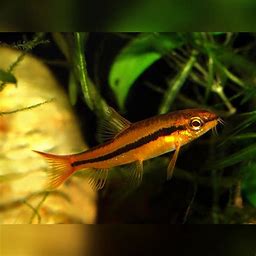ROSY LOACH (TUBEROSCHISTURA ARAKANENSIS)
Full Description
Rosy loaches (scientific name: Puntius conchonius) are small, peaceful, and colorful freshwater fish that are popular among aquarium enthusiasts. They’re known for their vibrant pinkish-orange coloration, which is how they get the “rosy” part of their name. Here’s a care guide to help you maintain a healthy environment for your rosy loach:
1. Tank Size
-
Minimum size: 20 gallons (for a small group).
-
Rosy loaches are active swimmers and thrive in a tank with plenty of space to explore. A larger tank will help keep water quality stable and provide them with a more natural environment.
2. Water Parameters
-
Temperature: 72°F to 79°F (22°C to 26°C). They’re tropical fish, so they prefer warm water.
-
pH level: 6.0 to 7.5 (neutral to slightly acidic).
-
Hardness: Soft to moderately hard water (4–12 dGH).
-
Regular water changes (about 25-30% per week) help keep the water clean and the loaches healthy.
3. Water Filtration
-
Since rosy loaches are active swimmers, it’s important to have a good filtration system to maintain water quality. A strong filter will help keep the tank clean and prevent buildup of harmful waste.
-
Make sure the filter’s current isn’t too strong for the loaches, as they prefer calm waters.
4. Tank Setup
-
Substrate: Fine gravel or soft sand is ideal. Loaches like to forage and dig, so avoid sharp substrates that could injure them.
-
Plants: Live plants like Java fern, Anubias, and Vallisneria work well. They provide cover and help oxygenate the water.
-
Hiding Spots: Include rocks, caves, or driftwood to create hiding spots. This helps them feel secure and reduces stress.
5. Diet
-
Rosy loaches are omnivores and will eat a variety of foods. You can feed them:
-
High-quality flake food or pellets.
-
Live or frozen food like brine shrimp, daphnia, or bloodworms.
-
Vegetables like blanched zucchini, spinach, or peas.
-
-
Make sure to vary their diet to ensure they get all the nutrients they need.
6. Tankmates
-
Rosy loaches are peaceful and social, making them great community fish. They thrive in groups of 5 or more, as this helps them feel more secure.
-
They do well with other peaceful species, such as:
-
Corydoras catfish.
-
Tetras.
-
Guppies.
-
Small rasboras.
-
-
Avoid keeping them with fin-nipping or aggressive species.
7. Behavior and Activity
-
Rosy loaches are active, and they enjoy swimming in the middle and lower areas of the tank.
-
They tend to be quite playful, and you may notice them interacting with each other, especially when they’re in a group.
-
While they are peaceful, they can be a bit shy at first. Providing a group and some plants or decorations for cover will help them feel more at ease.
8. Breeding
-
Breeding rosy loaches in captivity is possible but requires specific conditions. You’ll need a separate breeding tank with slightly cooler water (around 70°F/21°C).
-
The males typically chase the females, and once the eggs are laid (usually on plants or substrate), the males will fertilize them.
-
After breeding, remove the adults to avoid them eating the eggs. The eggs will hatch in about 2-3 days, and the fry should be fed infusoria or liquid fry food.
9. Common Health Issues
-
Ich: A common parasitic infection. Symptoms include white spots on the body. Treatment usually involves raising the water temperature and adding aquarium salt.
-
Fin rot: Can occur due to poor water quality or physical injury. Maintain good hygiene and quarantine affected fish if needed.
-
Dropsy: A condition that causes swelling. It can be caused by internal infections or stress, so check water quality and diet if you notice signs.
With proper care, rosy loaches can live up to 5-7 years in a well-maintained aquarium. They’re relatively hardy, making them a good choice for beginner to intermediate aquarium keepers. The key is maintaining stable water parameters and providing a balanced diet.
18 in stock

